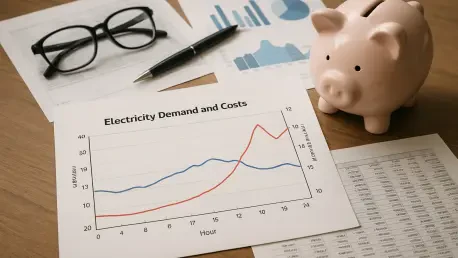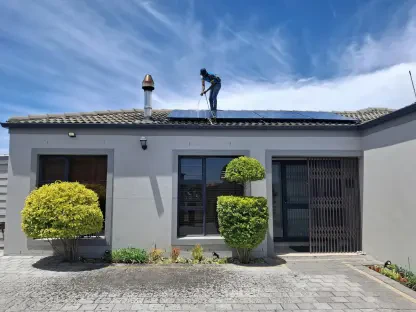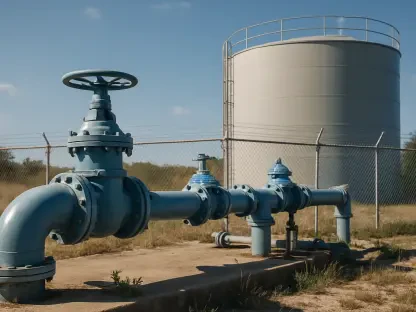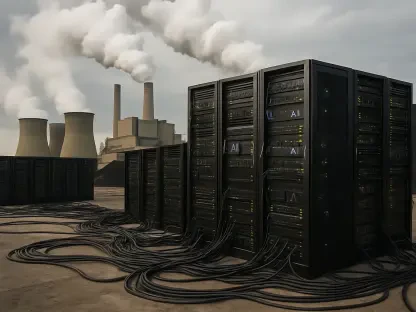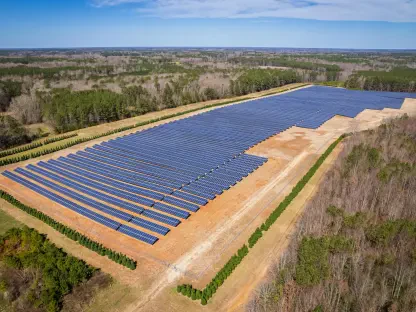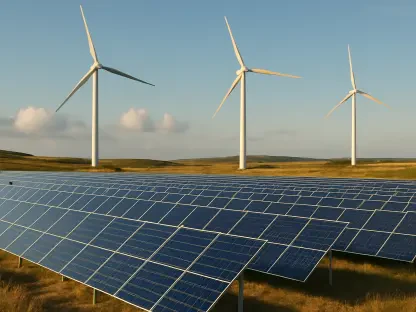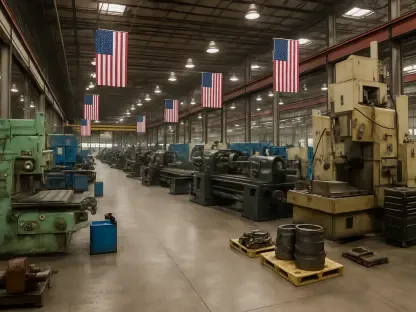What happens when the lights stay on, but the bills keep climbing? Across the nation, households and businesses are grappling with a stark reality: electricity demand is surging, and the costs are following suit, creating a challenging environment for many. A recent report from the U.S. Energy Information Administration (EIA) paints a vivid picture of a 3.8% spike in electricity generation and a 2.6% rise in retail sales for July compared to last year. This isn’t just a number—it’s a wake-up call about how technology, climate, and policy are reshaping the energy landscape. As air conditioners hum through scorching summers and data centers power the digital age, the question looms: can the grid—and consumer wallets—keep up?
The significance of this trend cannot be overstated. With residential electricity prices jumping 5.2% and even sharper increases in transportation (8.5%), industrial (6.2%), and commercial (4.8%) sectors, the financial burden is spreading fast. Beyond the immediate sting of higher bills, this signals a potential turning point for energy policy and infrastructure planning. The drivers are complex, from the explosive growth of AI-driven data centers to ambitious electrification goals, all against the backdrop of economic uncertainty and extreme weather. Understanding these shifts is critical for navigating what lies ahead in the power sector.
A Power Surge on the Horizon: Are Preparations Falling Short?
The numbers tell a compelling story of change. The EIA data highlights not just a seasonal uptick but a possible long-term shift in how much electricity the nation consumes. Hotter summers have pushed air conditioning usage to new heights, while industrial and tech sectors are drawing more power than ever. This isn’t merely about keeping cool—it’s about sustaining a digital economy that relies on constant energy flow. The question remains whether current systems can handle this growing appetite without buckling under pressure.
Beyond the raw demand, the cost implications are striking. Natural gas prices, a key fuel for power generation, have skyrocketed by 57.6% to $3.31 per million British thermal units at the Henry Hub. This surge directly inflates utility expenses, which are often passed down to end users. For many, this means rethinking budgets as electricity becomes a larger slice of monthly spending. The ripple effects touch everything from small businesses to sprawling factories, all feeling the pinch of tighter margins.
Why the Demand Spike Is a Critical Issue Today
In an era defined by rapid technological advancement, electricity is no longer just a utility—it’s the backbone of progress. Data centers, fueling the AI revolution, are estimated to account for nearly 60% of projected demand growth, according to energy market analysts. Simultaneously, policies pushing for electrification in transportation and manufacturing aim to cut carbon footprints but add significant load to the grid. These twin forces are redefining energy needs at a pace that traditional forecasting struggles to match.
Climate challenges compound the urgency. Record-breaking heatwaves have driven up consumption as cooling systems work overtime. Coupled with economic fluctuations, the stakes for energy reliability become even higher. A failure to adapt could mean not just higher costs but potential outages, disrupting everything from daily life to critical industries. The EIA’s reported increases in generation and sales are a clear indicator that action is needed now to address these converging pressures.
Breaking Down the Numbers: What’s Fueling the Cost and Demand Crisis?
A deeper look at the EIA findings reveals a multifaceted problem. Residential customers are seeing a 5.2% price hike, but the transportation sector faces an even steeper 8.5% increase, reflecting the high energy needs of electric vehicle charging networks. Industrial and commercial users aren’t spared either, with rises of 6.2% and 4.8%, respectively. These figures aren’t abstract—they translate into real challenges for businesses trying to balance operational costs in a competitive market.
The root causes are diverse yet interconnected. Beyond weather-driven spikes, the proliferation of data centers stands out as a major factor, with experts noting their outsized impact on grid demand. Infrastructure woes add another layer, as aging transmission lines and the high cost of upgrades—exacerbated by a 25% jump in material costs since the global supply chain disruptions—push expenses higher. Natural gas price volatility only intensifies the strain, leaving utilities with little choice but to adjust rates upward.
Policy decisions also play a role in this complex equation. Efforts to electrify various sectors, while environmentally sound, require massive grid capacity that isn’t yet fully in place. Constraints in expanding transmission networks mean that even when power is generated, getting it to where it’s needed remains a bottleneck. This inefficiency often results in higher costs for consumers, who bear the brunt of systemic growing pains.
Industry Insights: Experts Sound the Alarm on an Uncertain Path
Voices from the energy sector offer a mix of concern and cautious analysis. Peter Gardett, a seasoned analyst at Noreva, questions the longevity of this demand spike, stating, “Capital expenditure trends suggest a bigger story, but is this just a hot July or the start of something transformative? The data isn’t clear yet.” His perspective underscores the uncertainty that pervades even expert circles, as new variables like AI growth defy old prediction models.
Larry Paulhus of RINA North America focuses on the infrastructure challenge, warning, “Expanding generation and transmission isn’t just necessary—it’s urgent. But with material costs up 25% and tariffs on key resources, these investments hit consumers hard.” His comments highlight the inevitable trickle-down effect of systemic costs, painting a sobering picture for ratepayers. Meanwhile, Britt Burt of IIR Energy points to short-term fixes like delayed coal plant retirements, noting, “Near-record heat and new tech hubs are forcing tough calls to keep the grid stable, even if it means leaning on outdated plants.” These insights collectively reflect a sector at a crossroads, balancing immediate needs with long-term goals.
Charting a Course: Solutions for a Power-Hungry Era
Addressing this evolving crisis demands innovative thinking. Utilities and policymakers must overhaul outdated demand forecasting tools to better account for emerging trends like AI expansion and electrification. Current models fall short, often underestimating the scale of future needs. By integrating real-time data and advanced analytics, more accurate predictions can guide strategic investments, preventing costly missteps.
On the infrastructure front, targeted upgrades are essential. Prioritizing smart grid technologies can boost efficiency and reduce waste, helping to keep costs in check. For consumers, small changes like adopting energy-efficient appliances or shifting usage away from peak hours can mitigate bill increases. Additionally, regulators face the delicate task of aligning reliability measures—such as temporarily retaining coal plants—with sustainability targets, ensuring that short-term fixes don’t derail cleaner energy ambitions.
Looking ahead, collaboration across sectors offers a path forward. Public-private partnerships could accelerate grid modernization, while incentives for renewable energy adoption might ease reliance on volatile fossil fuels. These strategies, though not without challenges, provide a framework to manage rising demand without sacrificing affordability or environmental progress. The time to act is now, before temporary spikes harden into permanent burdens.
Reflecting on the Power Struggle
Looking back, the surge in electricity demand and costs revealed by the EIA report marked a pivotal moment for the energy sector. It exposed vulnerabilities in forecasting, infrastructure, and policy that had simmered beneath the surface for too long. The sharp rises in generation, sales, and prices served as a stark reminder of how interconnected technology, climate, and economics had become in shaping energy realities.
What stood out most was the urgency to adapt. Stakeholders had to pivot toward modernized systems and smarter investments to keep pace with a rapidly changing landscape. For consumers, the challenge was finding ways to conserve without compromising comfort or productivity. The path forward required not just reacting to price hikes but proactively building a grid resilient enough for future demands.
Ultimately, the lessons learned pointed to a broader need for innovation and cooperation. By embracing data-driven planning and sustainable solutions, the industry could transform this pressure point into an opportunity. The focus shifted to ensuring that the next wave of demand wouldn’t catch anyone off guard, setting a precedent for balancing power needs with economic and environmental priorities.
